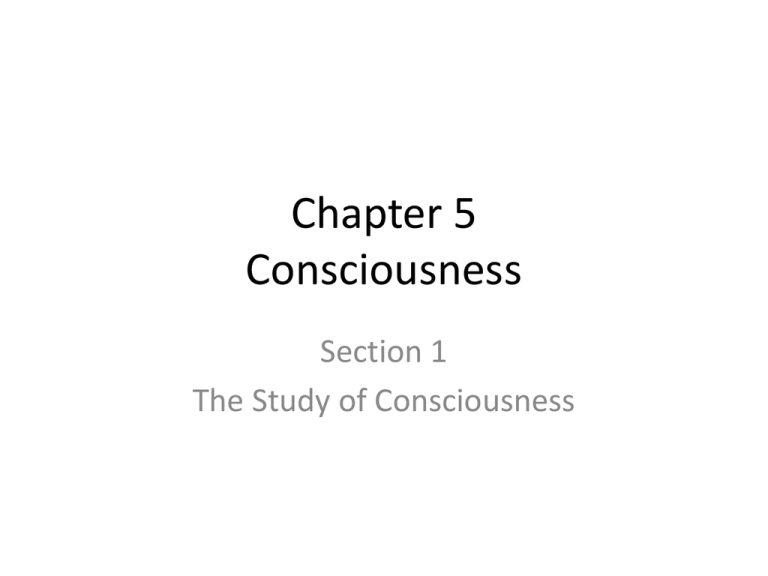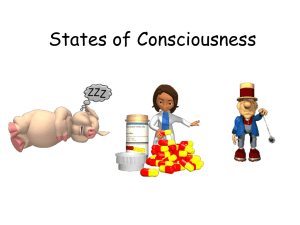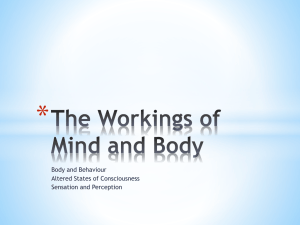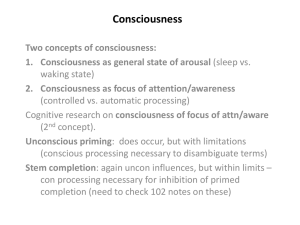Chapter 5 Consciousness
advertisement

Chapter 5 Consciousness Section 1 The Study of Consciousness 1 Consciousness as a Construct • Consciousness means the awareness of things that are both inside and outside ourselves Psychological Construct: something that can’t be seen, touched video video or measured directly • Early figures in psychology thought it couldn’t be scientifically studied because it is hard to measure or observe a person’s consciousness • Today many psychologists believe that consciousness can be studied because it can be linked with measurable behaviors (like talking) and with brain waves 2 Meanings of Consciousness Consciousness as Sensory Awareness • sensory awareness refers to being conscious of all the sights, sounds and smells in your environment at any given time • in other words, you are conscious, or aware, of things outside of yourself 3 Selective Attention Focusing on a particular stimulus is referred to as selective attention Example: to pay attention in class you must screen out the rustling of papers and the scraping of chairs Selective attention makes our senses keener (pick out the voice of a particular person across the room at a crowded party) 4 Consciousness as Direct Inner Awareness We don’t hear, see, smell or touch thoughts, images, emotions, or memories, yet we are still conscious of them Consciousness as direct inner awareness is being aware of things inside yourself 5 Consciousness as Sense of Self Children begin to develop an understanding that they are unique individuals, separate from other people and their surroundings The sense of self in which we are aware of ourselves and our existence Question: How can the memory of an event trigger an emotional response? What was your most embarrassing moment? Answer: The memory of the event is still in the consciousness, the individual is still aware of it, and the response is brought on by the image of our memory 6 The Preconscious Level Preconscious thoughts and ideas are not in your awareness now, but you can recall them Examples: what did you have for dinner last night? what did you wear to school yesterday? 7 The Unconscious Level Information stored in the unconscious (sometimes called subconscious) is unavailable to awareness most of the time In other words, it is hidden from the conscious mind. 8 Different Levels of Consciousness Freud: Exploring The Unconscious Mind 9 The Non-Conscious Level Many of our basic biological functions exist at the non-conscious level Examples: You know that you’re breathing in and out, but you cannot actually feel the exchange of carbon dioxide and oxygen You squint when you take your sunglasses off, but you can’t feel your pupils getting smaller 10 Altered States of Consciousness Altered states of consciousness occur when a person’s sense of the world changes (beyond consciousness) Examples: sleep, meditation, biofeedback, hypnosis, drugs and alcohol Section 2 Sleep and Dreams 1 The Sleep Cycle Much of how people, animals, and plants function is governed by Circadian Rhythms, or biological clocks We tend to associate periods of wakefulness and sleep with the rotation of the earth (day and night 24 hour cycle) Circadian rhythms in people cause changes in blood pressure, body temperature, sleepiness, and wakefulness over a 24 hour day 2 The Stages of Sleep Sleep stages are defined in terms of brain-wave patterns which can be measured by an electroencephalograph (EEG) When we are awake, the brain emits beta waves, which are short and quick When we are drowsy, the brain moves from beta waves to alpha waves which are slower than beta waves. You are falling into sleep. Ever feel like you’re falling? Flashes of color? This state is followed by five stages of sleep. 3 Stage 1 Lightest stage of sleep, brain waves slow down from the alpha rhythm to the slower pattern of theta waves May be accompanied by brief images that resemble vivid photographs, lasts no more than 30 or 40 minutes Stages 2,3 & 4 Deep sleep, brain produces delta waves (slowest brain wave pattern) Stage 4 is the deepest sleep, hardest time waking up during this stage 4 REM Sleep (Stage 5) After about a half hour of stage 4 sleep we cycle back through stage 3, to stage 2, to stage 1 About 90 minutes after we fall asleep we move into rapid eye movement stage (REM) under eyelids, eyes move rapidly Breathing becomes more irregular, blood pressure rises, heart beats faster Previous four stages known as NREM Over a typical 8 hours of sleep we go through these stages about five times, each one makes up one sleep cycle As the night goes on, periods of REM sleep become longer The Sleep Cycle Most people go through the cycle 5 times in 8 hours. As the night progresses, stages 3 and 4 become shorter and REM sleep becomes longer 5 Importance of Sleep Sleep to revive the tired body and to build up resistance to infection Also serves important psychological functions such as recovering from stress REM sleep seems to serve particular psychological functions. People who are deprived of REM sleep learn more slowly than usual, forget more rapidly what they’ve learned Research suggests that REM sleep may help brain development in infants and “exercise” brain cells in adults Page 138 reading video clip 6 Dreams Most vivid dreams occur during REM sleep, more likely to have vivid imagery and make sense even if some of the events aren’t realistic NREM sleep dreams are more vague and images more fleeting People seem to dream in “real time” and dreams are often an extension of the activities of the day Why are they sometimes hard to remember? Because it’s hard to hold on to Information from one state of consciousness when we move into another (sleeping/dreaming to wakefulness) Video clip 7 Freudian View of Dreams Freud theorized that dreams reflect a person’s unconscious wishes and urges Theorized people don’t always dream in direct or obvious forms, but rather, people dream in symbols Theorized that these “symbolic” dreams give people a way to deal with painful material that they cannot deal with consciously 8 The Biopsychological Approach Believe that dreams begin with biological, not psychological activity Theorize that during sleep, neurons fire in the part of the brain that controls movement and vision, that neurons fire at random and the brain tries to make sense of them (weaving a story) This approach explains why people often dream about events that happened earlier in the day Most recent brain activity dealt with problems of the day, so the brain uses everyday matter to give structure to random bursts of neurons during REM sleep Who’s right? Who knows? Activity: The Dreamer and the Dream Small Group Roles: Dreamer Freudian analyst Biopsychological analyst Dreamer will report a class-appropriate dream to the two analysts. Reminders: Freudian analyst: identify symbolism in the dream Biopsychological analyst: look for real events that have been woven into the story Analysts will write down and deliver their reports to the dreamer 9 Sleep Problems Insomnia Most common type of insomnia is difficulty falling asleep Psychologists recommend: • • • • tense the muscles one at a time and then let the tension go avoid worrying in bed, get up and do something else establish a regular go to bed and wake up time routine Use pleasant images to relax 10 Nightmares and Night Terrors Nightmares, like most other dreams, are products of REM sleep Night Terrors are similar to, but more severe than nightmares heart races, gasps for air, suddenly sit up, talk incoherently or thrash about, not fully wake up Tend to happen during the first couple of sleep cycles. Nightmares tend to happen more toward morning. Most common in young children 11 Sleepwalking Many children walk in their sleep, usually in deep stages of sleep May answer questions, but don’t remember what they said when they awake Most children outgrow sleepwalking 12 Sleep Apnea Sleep apnea is a breathing interruption that occurs during sleep About 10 million Americans have sleep apnea, associated with obesity and snoring Can lead to high blood pressure, heart attacks, and stroke 13 Narcolepsy Narcolepsy is a rare sleep disorder in which people suddenly fall asleep, no matter what time it is or where they are One minute they are awake, the next, their muscles completely relaxed in REM sleep Believed to be a genetic disorder of REM-sleep functioning Section 3 Altered States of Consciousness 1 Meditation and Biofeedback Meditation is a method some people use to try to narrow their consciousness so the stresses of the outside world fade away Focus on a peaceful, repetitive stimulus such as a mantra Important part of some religions such as Buddhism, “oneness with the universe” clip 2 Biofeedback Biofeedback is a system that provides, or “feeds back,” data about something happening in the body Allows people to control bodily functions previously regarded as not subject to conscious control Tension headaches High blood pressure ADHD 3 Hypnosis History of Hypnosis German physician Franz Mesmer in the late 1700’s. developed theory on magnetism (all parts of universe connected by forms of magnetism) To cure patients, passed magnets over their bodies, some would fall into a trance, Mesmer was dismissed as a quack Today: Used by some medical doctors as an anesthetic for minor surgery Some psychologists use it to help patients manage anxiety, or pain. Or to help patients overcome fears 4 Achieving Hypnosis Focus on an object or the hypnotist’s voice, usually suggest that arms and legs are becoming warm, heavy and relaxed. Becoming sleepy or are falling asleep Hypnosis is not sleep. People in trances have very different brain waves than people who are sleeping Hypnotic suggestibility: usually like the idea of being hypnotized and don’t resist Can only be hypnotized if they allow themselves to be 6 Explaining Hypnosis Freud used hypnosis to explore the unconscious. Believed hypnotized people would allow themselves to put fantasy and impulse before fact and logic Another View? Role play theory: people who are hypnotized are playing out a part as if they are in a play and believe what they’re doing is real (they enjoy the experience and believe what the hypnotist is telling them is real) There is no one generally accepted explanation for hypnosis Most researchers agree that it can and does work with certain patients 7 Uses for Hypnosis Psychologists continue to debate whether hypnosis has a scientific basis Hypnosis and Memory Has been used on occasion by the police to jog the memories of witnesses to a crime, but results unclear Hypnosis and Pain Prevention Has been used by dentists to help people avoid pain during certain procedures Some people so suggestible, undergo surgery without anesthesia if they are hypnotized and told they feel no pain Hypnosis and Quitting Bad Habits Therapist uses posthypnotic suggestion of behaviors to be carried out after the patient leaves Link the image of smoking with some image that would make the patient feel ill or disgusted if they light up Section 5 Drugs and Consciousness clip 1 Depressants Depressants are drugs that slow the activity of the nervous system. Generally give people a sense of relaxation but can have many negative side effects Include alcohol and narcotics such as barbiturates and opiates Alcohol is the most widely used drug in the United States Regular use can lead to addiction Withdrawal symptoms include tension and trembling Depressants: Heroin Morphine Oxycodone Methamphetamines Cocaine LSD Inhalants Marijuana/Cannabis Stimulants: Amphetamines Nicotine Hallucinogens: Ecstasy Peyote Other: Bath Salts 2 Narcotics Narcotics are addictive depressants that have been used to relieve pain and induce sleep Many narcotics (such as morphine, heroin, and codeine) are derived from the opium poppy plant Morphine used during the Civil War to relieve pain from wounds. Highly addictive Heroin introduced in the West in the 1800’s, seen as the “hero” that would end morphine addiction, also highly addictive Withdrawal symptoms tremors, cramps, chills, rapid heartbeat, insomnia, vomiting, diarrhea 3 Stimulants Nicotine Nicotine, the drug found in tobacco leaves is one of the most common stimulants Cigarettes, cigars, pipe tobacco, chewing tobacco Addictive substance, some research suggests it can be as addictive as the use of heroin Withdrawal symptoms: nervousness, loss of energy, insomnia, heart palpitations, dizziness Serious health risks, 400,000 Americans die each year 4 Stimulants Amphetamines Amphetamines are stimulants known for keeping people awake and for reducing appetite First used by soldiers during WWII to stay awake and alert during the night Pills, liquid form injected, meth (crushed, smoked, injected, snorted) Not a hallucinogen, but high doses can cause hallucinations (bugs) and delusions Highly addictive. Especially meth. Permanent brain, liver, kidney damage, “meth mouth” 5 Hallucinogens A hallucinogen is a drug that produces hallucinations. In addition may cause feelings of relaxation and pleasure. Marijuana Impairs coordination, studies report it also impairs memory and learning Effects on consciousness, may feel that time is passing very slowly LSD Much stronger than marijuana and can produce intense hallucinations Gained wide popularity in the 1960’s with the claim that it expands consciousness and “opens new worlds” Others: mushrooms, peyote, ecstasy 6 Types of Drug Treatment Detoxification: Removal of harmful substances from the body Maintenance Programs: Controlled amounts of drug given to participants Counseling: Group or individual sessions Support Groups: People with similar problems sharing common experiences • Alcoholics Anonymous





